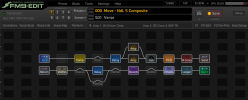Yes, absolutely the FM9 definitely works. In the end, it’s a tool in the performance not the performer itself. It seems the FM9 has attracted more Pdubz players to the world of Fractal, but there are way fewer than in the Helix world.
I used the Helix (Floor) for close to a year, had the Stomp on my pedalboard for a while (but couldn’t get over the input compression), and occasionally still use Helix Native. So I’m familiar with both modellers and workflows and can say that the FM9 and Helix are different enough in both workflow and performance so deciding on what’s best for you will depend on what elements are the most important.
For me - If I needed to choose between the Helix and FM9 right now - I’d confidently go all-in on the FM9. It’s easier to dial in amazing amp tones, there are way more options, the dynamics are more realistic, and the effects are classes above Line 6 (although I did love the delays in the Helix). Bottom line… I’ve never had so many ’I’ve found the perfect tone’ or ‘this sounds f*#king amazing’ with any other modeller or platform. Fractal is the shit….
That said there are a couple of areas where Helix does have the edge over the Fractal units:
- An audio gap in changing amp channels: As @unix-guy mentioned this isn’t a problem if you only use one amp at a time. You can add two amp blocks and switch between them, so changes are gapless. However, if you want to layer amps, change channels, and always have both amp blocks engaged (like I do) you will just have to accept that there is a micro audio gap when changing channels. I notice the gap when playing live… It bothers me a little… but once you learn to change scenes/channels just before the downbeat of the next section, add some delay and reverb… it’s almost a non-issue. That said, IMO, gapless changes should be the goal for the Fractal product range. Helix has it with Snapshots... the naysayers will say it's different and in some ways it is... but the end product isn't. One can change every setting on the model without audio gaps while the other can do limited changes before needing to change channels and add a audio gap... Queue the eternal debate

- Explosive delay and reverb artefacts: This is my biggest downer with the Fractal products. When changing channels on Delays, Plex-Delay, and Reverb blocks you will occasionally encounter an explosion of trails which can be at the same volume or higher depending on what you’re playing. It’s more prominent when switching between ambient tones with higher wet mix levels and longer trails or decay times. There are workarounds but only if you have other blocks free and available CPU to run them all. If you’re already using the two delay blocks (I have one before the amp and one after) or the Plex-Delay block it’s not so simple and there isn’t a workaround for it. I still have to make concessions or turn down/off the output when changing ambient sounds when the band is playing quietly… I’ve learned that the hard way and unfortunately that isn’t confidence-inspiring when playing live. I still don’t understand why this behaviour hasn’t been corrected … in no live environment is that explosive delay/reverb spillover acceptable/desirable.
For me, the benefits massively outweigh the drawbacks (in my use it's really only the delay/verb explosions). If you can work around the above (mentally or technically) everything else about Fractal is absolutely amazing...


